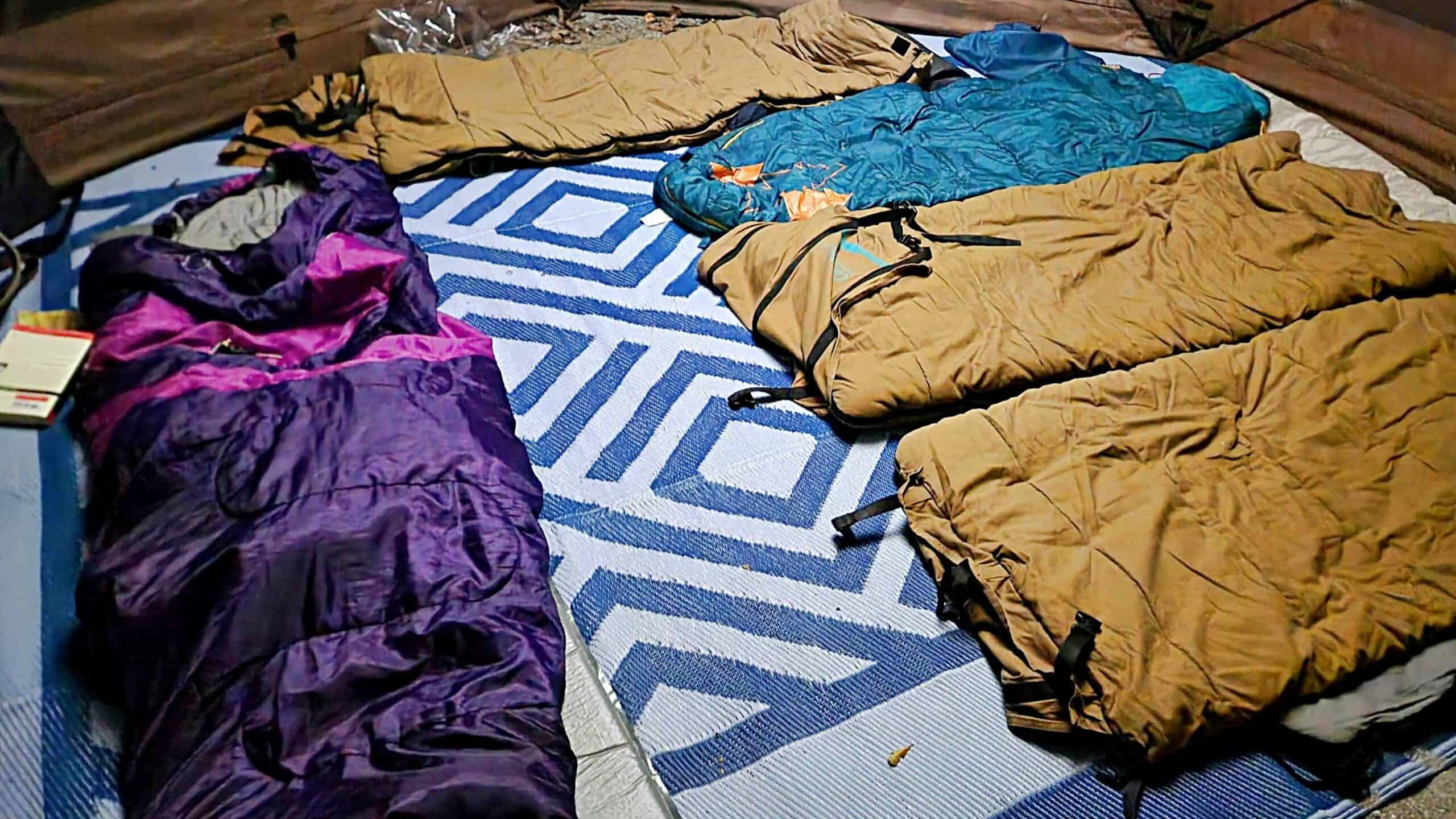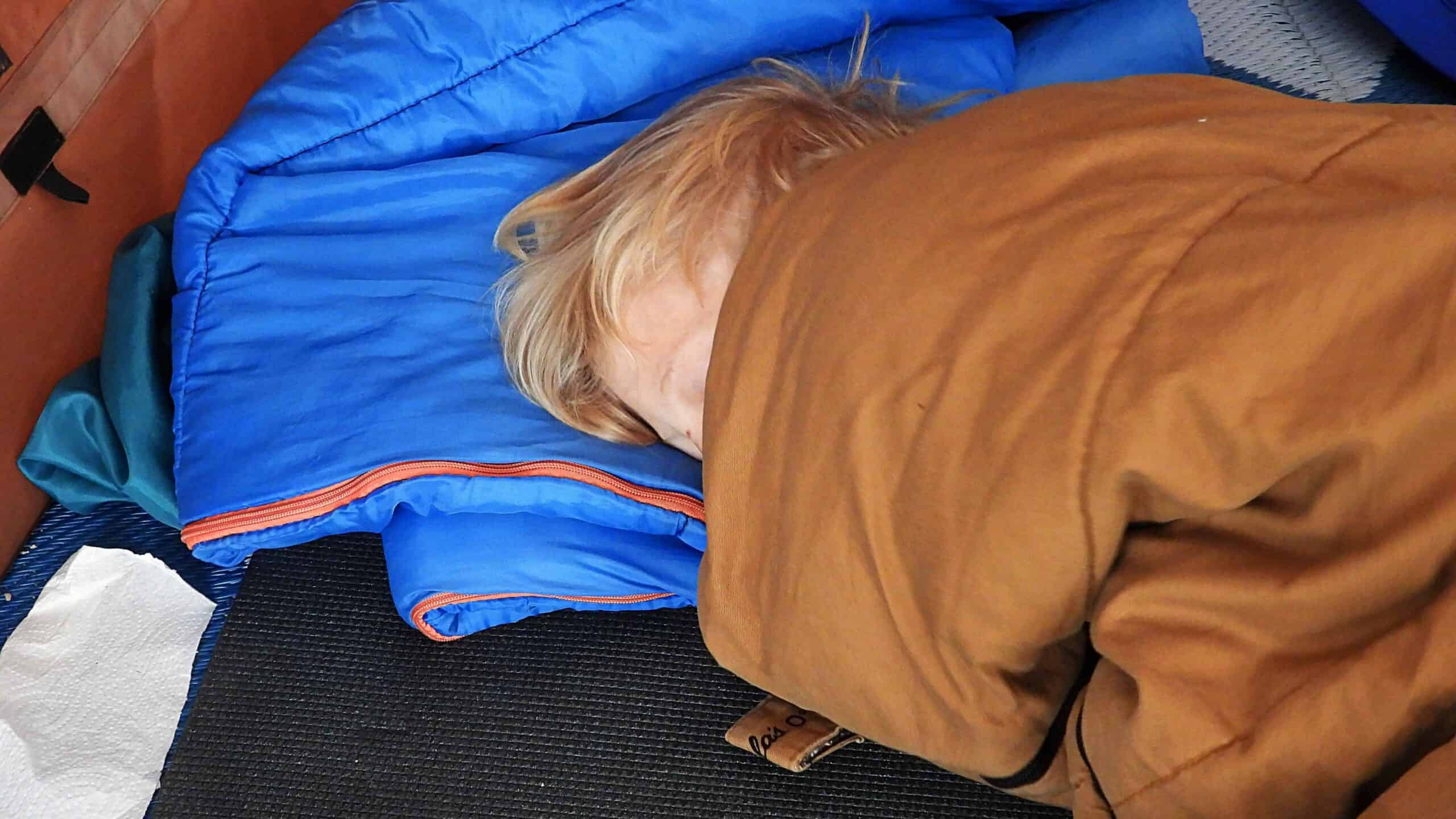Parents who are planning camping trips have a lot to think about. One important thing to consider is what age a child can use a sleeping bag.
In general, camping sleeping bags aren’t safe for children under the age of 3. Adult and child sleeping bags are too large for toddlers and babies, and they can slip inside, creating an increased risk for suffocation and SUID (Sudden Unexpected Infant Death). Safe sleep guidelines dictate never using blankets with babies.
There are some very good reasons why you shouldn’t use a sleeping bag for toddlers or infants.
The Best Age to Use Sleeping Bags While Camping
Most people use sleeping bags to stay warm while camping but it isn’t so simple if you have babies or young toddlers. Are sleeping bags even safe for these ages? What if they slide down and get stuck, or wiggle out and get cold?
Put simply, it’s impossible to follow safe sleep guidelines while using ordinary camping sleeping bags. According to the American Academy of Pediatrics and other health organizations, babies shouldn’t sleep with anything in their beds, including blankets, pillows, or other bedding. Not only are regular sleeping bags thick and heavy, but they’re too large for babies and toddlers, who can easily slip down inside the bag. This creates a dangerous situation where children might not be able to breathe well.
For these reasons, children under the age of 3 shouldn’t use adult or child sleeping bags or heavy blankets while camping. Use special caution when planning sleeping arrangements for toddlers and babies under the age of 2.

Why Sleeping Bags Aren’t Safe for Babies and Toddlers
While sleeping bags are excellent for keeping adults and older children warm all night long, they aren’t considered safe for babies. Safe sleep standards for babies include placing them on their back to sleep and keeping extra items such as stuffed animals, heavy blankets, and pillows out of their cribs. Sleeping bags are too heavy and thick to be safe for babies, and because they’re enclosed on the sides it’s possible for babies and toddlers to scoot down into the bag and become entangled. There is even the potential that they could struggle to breathe if they wiggle too far down into the sleeping bag. For this reason, it is not recommended that babies and toddlers under the age of two or three sleep in regular sleeping bags.
Once they’re over the age of three, preschoolers can safely sleep in child-sized sleeping bags. Again, it’s essential that the bag be small enough that the child can’t become entangled or stuck in the bottom of the bag while they’re sleeping.
What Your Baby Can Sleep in Instead of a Sleeping Bag
There are alternatives to sleeping bags when camping, especially if it’s not going to be too cold (under 55-60° or so). At these temperatures, you can use many different things for your kids to sleep in which might save you money and help your child sleep easier. If it’s going to be colder than that, you can still find safe sleeping arrangements for babies, but there are fewer options and you might have to spend a little more.
Here are sleeping options for your child who’s too young for normal sleeping bags:
Morrison Outdoors Sleeping Bag: These sleeping bags are designed for infants and children. Instead of having a large opening, they have neck holes and arms like a sleep sack. While these infant sleeping bags aren’t certified for safe sleep (as far as I know, no sleeping bags are available with that certification) they are”designed to meet all AAP-recommended guidelines for safe infant sleep.” For kids who are camping in cold temperatures, this is one of the best options, with options down to 20°.
Regular Sleep Sack: If it’s not going to be too cold, consider letting your baby sleep in a regular sleep sack. Dress them in warm pajamas or thermals and then use a heavy sleep sack designed to replace a blanket for safer sleep. If it’s under 65° or so, make sure to use a thick, warm sleep sack. These sacks are easy to find and are a great alternative to a sleeping bag. Make sure your baby is on a warm, firm surface like a portable crib so they won’t get chilled from the cold ground.
Heavy Pajamas: In moderate weather, a layer or double layer of pajamas is often enough to keep your baby warm for the night. Use a moisture-wicking inner layer such as thermals, and then a heavier, looser outer layer on top. Make sure your outer layer isn’t too bulky or tight or your baby will feel constricted. This is a great option for people who are camping in relatively warm weather or who will only go out a few times a year. You can save money and purchase a larger sleeping bag once your toddler is a few years older and they will be able to use it for longer.
Sleeping Pad and Blanket: You can also use a regular sleeping pad and blanket for older toddlers (those over 12 months old) just as you would at home. Make sure the blanket isn’t too heavy and use a firm sleeping pad (preferably not an air mattress). This may be safer than a sleeping bag because it’s not enclosed. Your toddler might get the blanket over his head, but he won’t get entangled or trapped like he could in a sleeping bag. This isn’t safe for infants, so stick with other options for kids under 12 months.
Snowsuit: Snowsuits have many of the features of sleeping bags: They have waterproof outer shells and thick insulation, and are designed to keep out the cold. Dress your child in thermals or other warm, moisture-wicking layers before putting them in their snowsuit for the night since they usually feel plasticky inside. Remember, snowsuits aren’t designed for sleep, so keep a close eye on your baby when using this method. For extra safety, stick to options with removable hoods, like this one. Keep their heads warm with a hat, instead.

Conclusion
Whatever you use for your baby to sleep in while camping, make sure that you are following the recommended guidelines for safe sleep. Many people let their standards slip for occasional outings like camping, vacations, and visiting family, but you should always follow best sleep practices to protect your child.




